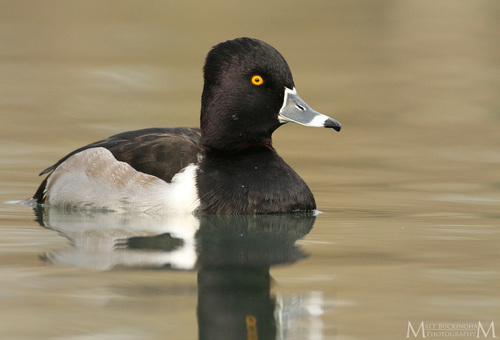
Ring-necked Duck
The Ring-necked Duck (Aythya collaris) is a diving duck found in North America. Despite its name, the 'ring' on its neck is often inconspicuous, and it is more easily identified by the white ring on its bill. These ducks play a crucial role in their freshwater ecosystems, primarily consuming aquatic plants and invertebrates, which helps maintain a healthy balance in their habitats. Ring-necked Ducks have little known cultural significance, but they are prized by birdwatchers for their distinctive appearance and diving behaviors.
38-46 cm
Length
60-70 cm
Wingspan
Least Concern
Conservation Status
Distribution
Breeds primarily in Canada and the northern United States, with some populations in Alaska. Migrates south to the southern United States, Mexico, and Central America for the winter. Occasionally found in the Caribbean.
Lifespan
Up to 8-10 years in the wild; can live longer in captivity. Not Evaluated
Ring-necked Duck's Habitat
Habitat Types
Freshwater marshes, Shallow lakes, Ponds, Bogs, Slow-moving rivers
Climate Zones
Temperate, Boreal
Adaptations
These ducks are adapted to diving, with legs set back on their bodies for efficient underwater propulsion. They have specialized bills that allow them to filter food from water and mud.
Variations
No recognized subspecies.
Appearance
Breeding Plumage
Males have a glossy black back, chest, and head with purplish sheen during breeding season. Females are brown. Non-breeding males resemble females but retain some darker features.
Seasonal Feather Changes
Males molt into a duller plumage (eclipse plumage) after breeding, resembling females.
Sex Based Plumage Differences
Males have black back and chest, white flanks, and a distinct white ring on the bill. Females are overall brown with a less prominent bill ring.
Notable Features
White ring on the bill, Peaked head shape, Dark, glossy plumage (males in breeding season)
Diet and Feeding
Primary Foods
Aquatic plants, Seeds, Insects, Mollusks, Crustaceans
Foraging Behavior
Dives underwater to feed, often in shallow water. They typically upend themselves to reach vegetation and invertebrates on the bottom.
Specializations
Their bill has lamellae (comb-like structures) to filter small food items from the water.
Seasonal Diet Variations
Diet shifts with seasonal availability. More plant-based in summer, with a higher proportion of invertebrates during breeding season for protein.
Behavior
Social Structure
Forms large flocks during migration and winter. Breeding pairs are more territorial.
Communication
Soft, purring calls by males during courtship, Quacking calls by females, Visual displays like head-throws and wing-flapping
Migration
Migrates in large flocks, often at night. Follows general north-south routes, using inland waterways.
Territorial or Group Behaviors
Males defend territories around the nest during breeding season. Forms large, mixed-species flocks with other diving ducks in winter.
Conservation
Threats
Habitat loss and degradation, Pollution of wetlands, Lead poisoning from ingestion of spent shot
Protection Programs
Wetland conservation and restoration efforts, Regulations on lead shot use in some areas
Local National Laws
Protected under the Migratory Bird Treaty Act in the US and Canada.
Population Trend
Stable
Population Estimates
Estimated global population of 1.2 - 1.4 million individuals.
Interesting Facts
Misleading Name
The 'ring-neck' is rarely visible; the white bill ring is a much better field mark.
Expert Divers
They can stay underwater for up to 30 seconds while foraging.
Mixed Flocks
Often found in mixed flocks with other duck species, especially scaup, during migration.
Faqs about Ring-necked Duck
Why is it called 'Ring-necked' if the ring is hard to see?
The name refers to a chestnut-colored ring around the neck, but it's often faint and difficult to see in the field. Early ornithologists may have observed it more clearly in hand.
Where can I see Ring-necked Ducks?
Look for them on freshwater lakes, ponds, and marshes during migration and winter. They are widespread across North America.
Do they mate for life?
They form seasonal pair bonds, meaning they choose a new mate each breeding season.
Are Ring-necked Ducks good to eat?
Like many diving ducks, Ring-necked Ducks can have a slightly fishy taste depending on their diet, some hunters prize them, while others prefer other duck species.
Copyright @ Nature Style Limited. All Rights Reserved.
 English
English